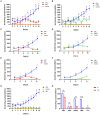Comparative Study on Different Skin Pruritus Mouse Models
- PMID: 33708782
- PMCID: PMC7940346
- DOI: 10.3389/fmed.2021.630237
Comparative Study on Different Skin Pruritus Mouse Models
Abstract
The animal model is an important tool to study the mechanism of disease formation. Different animal models of pruritus have been adopted based on the purpose of researchers in the study of the itching mechanism. Although the symptoms of various models are quite different, scratching behavior is a key indicator. Therefore, it is necessary to find an animal model that can quickly induce animal scratching and maintain the stability of scratching behavior. In this study, we compared animal models of pruritus induced by four substances and found that the scratching behavior of mice induced by urushiol not only reached the plateau stage quickly but also showed more stability in the plateau phase than that induced by 2,4-dinitrofluorobenzene, oxazolone, and imiquimod. Meanwhile, in the animal model induced by urushiol, the changes of epidermal thickening and inflammatory cell aggregation were also more obvious. In addition, pruritus induced by urushiol is prevalent all over the world, especially in the United States and Europe, involving outdoor groups such as firefighters, forest loggers, and farmers. Therefore, we believe that the urushiol-induced animal model is an ideal choice for the study of the itch formation mechanism and the development of antipruritic drugs.
Keywords: allergic contact dermatitis; animal model; atopic dermatitis; pruritus; psoriasis; urushiol.
Copyright © 2021 Donglang, Tongtong, Dan, Chan, Changming, Guang, Yan and Zongxiang.
Conflict of interest statement
The authors declare that the research was conducted in the absence of any commercial or financial relationships that could be construed as a potential conflict of interest.
Figures



References
LinkOut - more resources
Full Text Sources
Other Literature Sources
Research Materials

